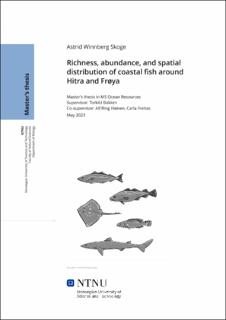| dc.contributor.advisor | Bakken, Torkild | |
| dc.contributor.advisor | Kleiven, Alf Ring | |
| dc.contributor.advisor | Freitas, Carla | |
| dc.contributor.author | Skoge, Astrid Winnberg | |
| dc.date.accessioned | 2023-07-11T17:23:53Z | |
| dc.date.available | 2023-07-11T17:23:53Z | |
| dc.date.issued | 2023 | |
| dc.identifier | no.ntnu:inspera:141153294:34432880 | |
| dc.identifier.uri | https://hdl.handle.net/11250/3077931 | |
| dc.description.abstract | I denne masteroppgaven har jeg brukt 228 timer med stereo-BRUV-data samlet over to år langs kysten av Hitra og Frøya til å observere effekten av bølgeeksponering, strømhastighet, temperatur og dybde på artsrikhet og artstetthet, lengde og romlig fordeling av torsk (Gadus morhua), bergnebb (Ctenolabrus rupestris), blåstål/rødnebb (labrus mixtus), pigghå (Squalus acanthias), kveite (Hippoglossus hippoglossus), piggskate (Raja clavata), lyr (Pollachius pollachius) og sei (Pollachius virens). Disse åtte fiskeartene assosierte på ulik måte med miljøvariablene jeg undersøkte, noe som indikerer ulik habitatbruk mellom artene på en liten romlig skala innenfor studieområdet. Romlig fordeling av arter i studeområdet var påvirket av artenes miljøbehov. Forholdene som avdekkes i denne studien har implikasjoner for økosystembasert forvaltning generelt, og er spesielt viktig i forhold til et planlagt marint bevaringsområde i en del av studieområdet. Forvaltningsstrategier som har som mål å bevare økosystemet er nødt til å ta hensyn til hele fiskesamfunnet og hver enkelt arts biotiske og abiotiske tilknytninger. Biodiversitet og artsrikhet beskyttes ikke kun gjennom vern av en enkelt art, men gjennom bevaring av hele fiskesamfunnet, deres foretrukne miljø- og romlige behov, og et mangfoldig habitat med nisjer som dekker hele samfunnets behov. | |
| dc.description.abstract | In this master thesis, 228 hours of stereo-BRUV data collected over two years in the coastal areas surrounding Hitra and Frøya were analysed to observe the effects of wave exposure, current speed, temperature and depth on species richness as well as abundance, length and spatial distribution of Atlantic cod (Gadus morhua), goldsinny wrasse (Ctenolabrus rupestris), cuckoo wrasse (Labrus mixtus), spiny dogfish (Squalus acanthias), Atlantic halibut (Hippoglossus hippoglossus), thornback ray (Raja clavate), pollock (Pollachius pollachius) and saithe (Pollachius virens). The eight fish species examined in this study all had different associations with the environmental variables, indicating different habitat use within the small spatial scale of the study area. Spatial distribution of these species was affected by the species preferred environmental ranges. The associations uncovered in this study has implications for ecosystem-based management in general, and specifically for the planned implementation of a marine protected area (MPA) in one part of the study area. Management strategies that aspire to protect the whole ecosystem will need to consider all species within the fish community and their biotic and abiotic associations. Biodiversity and species richness is not only protected through the protection of the one species alone, but through protection of the whole fish community, their environmental and spatial range, and a diverse habitat covering niches on a community level. | |
| dc.language | eng | |
| dc.publisher | NTNU | |
| dc.title | Richness, abundance, and spatial distribution of coastal fish around Hitra and Frøya: A stereo-BRUV survey | |
| dc.type | Master thesis | |
